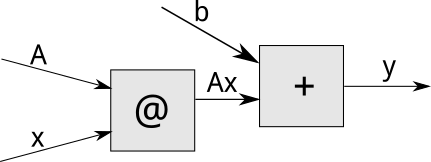Hi,
suppose we have the following code:
A = torch.eye(2, requires_grad=True)
b = torch.ones(2, requires_grad=True)
x = torch.Tensor([1, 2])
y = A@x + b # y = tensor([2, 3])
This instantiates (and automatically runs) a computation graph which looks something like

Now, suppose one of the leaf variables changes:
A.data[0, 0] = 3
Now, if we wish to get the new value of y, we need to manually run all the calculations (I think this instantiates a new graph which looks exactly the same - but I may be wrong here):
y = A@x + b # y = tensor([4, 3])
Is there a more automatic way to recompute/rerun the computation graph after some of the elements have changed?
I know that, in principle, I could contain the whole process of computing y inside a single function - and then just call that function again after the change. The problem with this is that my actual application involves multiple passes through the network, each with different data, as well as multiple calls to backward(create_graph=True), and so wrapping everything in a single function would cause a mess from the software architecture and code readability perspective.
So, I would be grateful if someone could point me to a cleaner way of rerunning an existing graph. The ideal solution here would be a function in line of y.recompute_from_graph().
